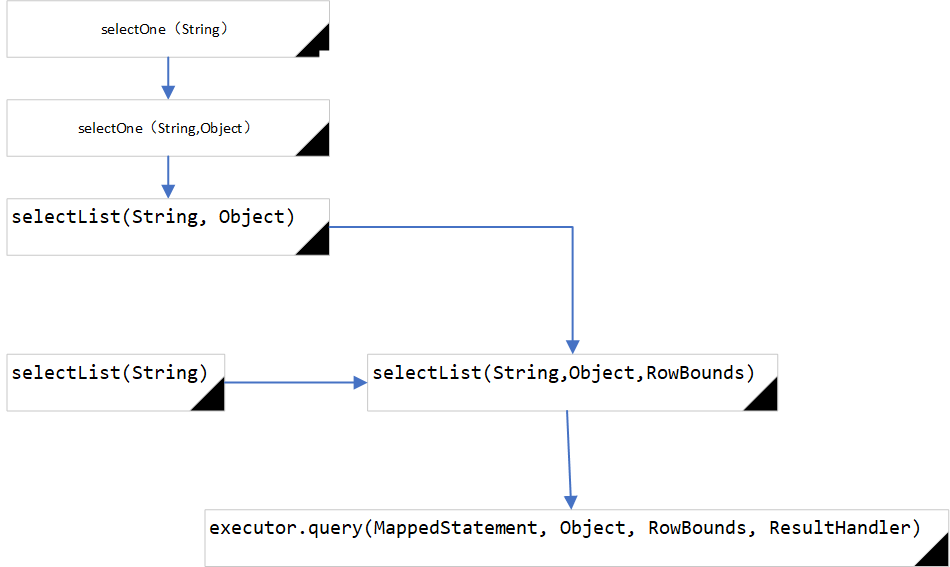SqlSession是mybatis的核心接口,SqlSessionFactory负责创建SqlSession对象,包含多个openSession()方法的重载。
在SqlSession中定义了常用的数据库操作以及事务操作,接口定义如下
SqlSession
1
2
3
4
5
6
7
8
9
10
11
12
13
14
15
16
17
18
19
20
21
22
23
24
25
26
27
28
29
30
31
32
33
34
35
36
37
38
39
40
41
42
43
44
45
46
47
48
49
50
51
52
53
54
55
56
57
58
59
60
61
62
63
64
65
66
67
68
69
70
71
| public interface SqlSession extends Closeable {
<T> T selectOne(String statement);
<T> T selectOne(String statement, Object parameter);
<E> List<E> selectList(String statement);
<E> List<E> selectList(String statement, Object parameter);
<E> List<E> selectList(String statement, Object parameter, RowBounds rowBounds);
<K, V> Map<K, V> selectMap(String statement, String mapKey);
<K, V> Map<K, V> selectMap(String statement, Object parameter, String mapKey);
<K, V> Map<K, V> selectMap(String statement, Object parameter, String mapKey, RowBounds rowBounds);
<T> Cursor<T> selectCursor(String statement);
<T> Cursor<T> selectCursor(String statement, Object parameter);
<T> Cursor<T> selectCursor(String statement, Object parameter, RowBounds rowBounds);
void select(String statement, Object parameter, ResultHandler handler);
void select(String statement, ResultHandler handler);
void select(String statement, Object parameter, RowBounds rowBounds, ResultHandler handler);
int insert(String statement);
int insert(String statement, Object parameter);
int update(String statement);
int update(String statement, Object parameter);
int delete(String statement);
int delete(String statement, Object parameter);
void commit();
void commit(boolean force);
void rollback();
void rollback(boolean force);
List<BatchResult> flushStatements();
@Override
void close();
void clearCache();
Configuration getConfiguration();
<T> T getMapper(Class<T> type);
Connection getConnection();
}
|
MyBatis为SqlSession提供了默认实现,DefaultSqlSession类
1
2
3
4
5
6
7
8
9
10
|
private final Configuration configuration;
private final Executor executor;
private final boolean autoCommit;
private boolean dirty;
private List<Cursor<?>> cursorList;
|
所有的数据库相关操作全部封装到了Executor接口实现中,DefaultSqlSession类中查询方法的调用关系如下图
![]()
查询最终都是调用Executor.query(MappedStatement, Object, RowBounds, ResultHandler)方法实现数据库查询操作的。
对返回对象进行调整
- selectOne()方法从结果集中获取第一个元素返回
- selectMap()方法将List集合转为Map集合返回
- select()方法将结果对象集合交由用户指定的ResultHandler对象处理,且没有返回值
- selectList()方法直接将集合返回
DefaultSqlSession中的insert()、update()、delete()方法最后通过调用DefaultSqlSession.update(String,Object)方法,从而调用Executor.update(MappedStatement, Object)方法完成数据库的修改操作。
DefaultSqlSessionFactory
DefaultSqlSessionFactory实现了SqlSessionFactory接口,提供了两种创建DefaultSqlSession的方式
方式一
通过数据源获取数据库连接,并创建Executor对象以及DefaultSqlSession对象
1
2
3
4
5
6
7
8
9
10
11
12
13
14
15
16
17
18
19
20
21
22
|
private SqlSession openSessionFromDataSource(ExecutorType execType, TransactionIsolationLevel level, boolean autoCommit) {
Transaction tx = null;
try {
final Environment environment = configuration.getEnvironment();
final TransactionFactory transactionFactory = getTransactionFactoryFromEnvironment(environment);
tx = transactionFactory.newTransaction(environment.getDataSource(), level, autoCommit);
final Executor executor = configuration.newExecutor(tx, execType);
return new DefaultSqlSession(configuration, executor, autoCommit);
} catch (Exception e) {
closeTransaction(tx);
throw ExceptionFactory.wrapException("Error opening session. Cause: " + e, e);
} finally {
ErrorContext.instance().reset();
}
}
|
方式二
用户提供数据库连接,根据数据库连接创建Executor对象以及DefaultSqlSession对象
1
2
3
4
5
6
7
8
9
10
11
12
13
14
15
16
17
18
19
20
21
| private SqlSession openSessionFromConnection(ExecutorType execType, Connection connection) {
try {
boolean autoCommit;
try {
autoCommit = connection.getAutoCommit();
} catch (SQLException e) {
autoCommit = true;
}
final Environment environment = configuration.getEnvironment();
final TransactionFactory transactionFactory = getTransactionFactoryFromEnvironment(environment);
final Transaction tx = transactionFactory.newTransaction(connection);
final Executor executor = configuration.newExecutor(tx, execType);
return new DefaultSqlSession(configuration, executor, autoCommit);
} catch (Exception e) {
throw ExceptionFactory.wrapException("Error opening session. Cause: " + e, e);
} finally {
ErrorContext.instance().reset();
}
}
|
SqlSessionManager
SqlSessionManager同时实现了SqlSessionFactory和SqlSession接口,也提供了SqlSessionFactory创建SqlSession对象以及SqlSession操作数据库的功能。
1
2
3
4
5
| private final SqlSessionFactory sqlSessionFactory;
private final SqlSession sqlSessionProxy;
private final ThreadLocal<SqlSession> localSqlSession = new ThreadLocal();
|
SqlSessionManager与DefaultSqlSessionFactory主要不同点是SqlSessionManager提供了两种模式:第一种模式和DefaultSqlSessionFactory的行为相同,同一个线程每次通过SqlSessionManager对象访问数据库时,都会创建新的DefaultSession对象完成数据库操作
第二种模式是SqlSessionManager通过localSqlSession这个ThreadLocal变量,记录当前线程绑定的SqlSession对象,供当前线程循环使用,从而避免在同一个线程多次创建SqlSession对象带来的性能损失
1
2
3
4
5
|
private SqlSessionManager(SqlSessionFactory sqlSessionFactory) {
this.sqlSessionFactory = sqlSessionFactory;
this.sqlSessionProxy = (SqlSession)Proxy.newProxyInstance(SqlSessionFactory.class.getClassLoader(), new Class[]{SqlSession.class}, new SqlSessionManager.SqlSessionInterceptor());
}
|
1
2
3
4
5
6
7
8
9
10
11
12
13
14
15
16
17
18
19
20
21
22
23
24
25
26
27
28
29
| private class SqlSessionInterceptor implements InvocationHandler {
public SqlSessionInterceptor() {
}
@Override
public Object invoke(Object proxy, Method method, Object[] args) throws Throwable {
final SqlSession sqlSession = SqlSessionManager.this.localSqlSession.get();
if (sqlSession != null) {
try {
return method.invoke(sqlSession, args);
} catch (Throwable t) {
throw ExceptionUtil.unwrapThrowable(t);
}
} else {
try (SqlSession autoSqlSession = openSession()) {
try {
final Object result = method.invoke(autoSqlSession, args);
autoSqlSession.commit();
return result;
} catch (Throwable t) {
autoSqlSession.rollback();
throw ExceptionUtil.unwrapThrowable(t);
}
}
}
}
}
|
四大对象
sqlSession真正的执行时通过Executor、StatementHandler、ParameterHandler、ResultSetHandler来完成数据库操作和结果返回
- Executor 执行器 通过执行器来调度StatementHandler、ParameterHandler和ResultHandler等来执行对应的sql
- StatementHandler 使用数据库的Statement/PreparedStatement执行操作
- ParameterHandler 用于sql对参数的处理
- ResultSetHandler 进行结果集ResultSet的封装和返回
 查询最终都是调用Executor.query(MappedStatement, Object, RowBounds, ResultHandler)方法实现数据库查询操作的。
对返回对象进行调整
查询最终都是调用Executor.query(MappedStatement, Object, RowBounds, ResultHandler)方法实现数据库查询操作的。
对返回对象进行调整
v1.3.10